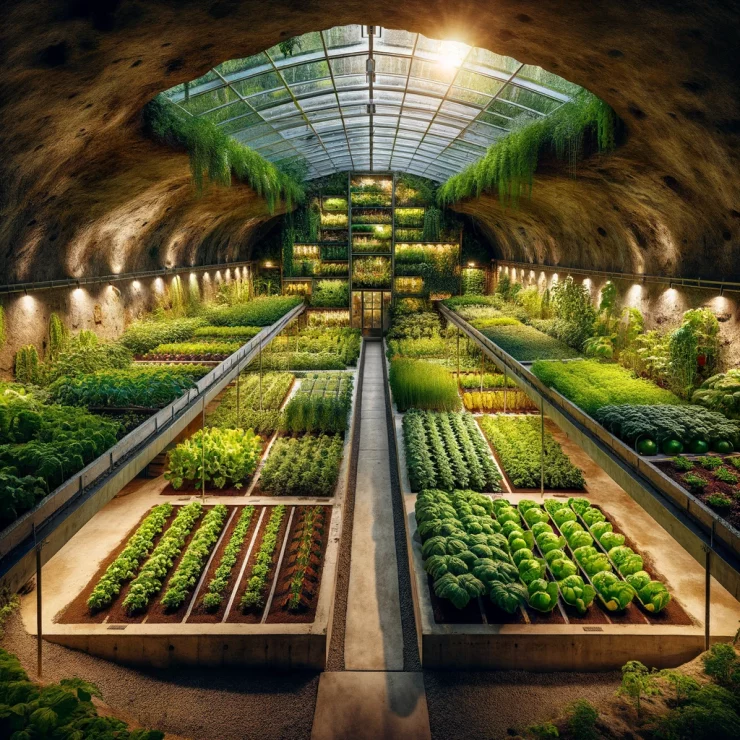Innovative farming techniques have been evolving rapidly to combat the challenges posed by climate change, land scarcity, and seasonal limitations. One such revolutionary approach gaining traction is the concept of underground greenhouses. By harnessing the natural insulation provided by the earth, these subterranean structures offer a sustainable solution to extending the growing season and ensuring a steady food supply throughout the year.

Traditional above-ground greenhouses have long been utilized to create controlled environments for cultivation. However, they often struggle to maintain consistent temperatures, especially in extreme climates. In contrast, underground greenhouses leverage the thermal mass of the soil to regulate temperatures effectively, providing a stable and conducive environment for plant growth.
One of the primary advantages of underground greenhouses is their ability to mitigate the effects of external weather conditions. By being partially or entirely buried beneath the surface, these structures are shielded from harsh winds, frost, and excessive heat, thereby minimizing the need for artificial heating or cooling systems. This natural insulation not only reduces energy consumption but also enhances the resilience of crops against fluctuating temperatures.
Moreover, underground greenhouses offer significant space-saving benefits, making them particularly suitable for urban areas where land is scarce. By utilizing the space below ground, farmers can maximize their cultivation area without encroaching on valuable surface land. This compact footprint makes it feasible to establish productive gardens even in densely populated cities, promoting local food production and reducing the carbon footprint associated with transportation.
The design of underground greenhouses varies depending on factors such as climate, soil type, and intended crops. Some structures may feature a sunken design with a transparent roof or skylights to allow sunlight to penetrate, while others utilize reflective surfaces to distribute light evenly throughout the space. Additionally, efficient ventilation systems are incorporated to ensure adequate airflow and prevent humidity buildup, which could lead to mold or mildew.
In regions with extreme climates, such as arid deserts or frigid tundras, underground greenhouses offer a lifeline for agricultural sustainability. By creating a controlled microclimate underground, farmers can cultivate a diverse range of crops that would otherwise struggle to thrive in such harsh environments. This not only enhances food security but also contributes to biodiversity conservation by preserving local plant varieties.
Furthermore, the year-round availability of fresh produce from underground greenhouses has numerous societal benefits. It reduces reliance on imported goods, thereby strengthening local economies and fostering self-sufficiency. Additionally, access to nutritious, locally grown fruits and vegetables promotes healthier dietary habits and reduces the prevalence of food deserts in underserved communities.
Despite their numerous advantages, underground greenhouses also present some challenges. Construction costs can be higher than traditional above-ground structures due to the excavation and reinforcement required. Additionally, proper maintenance and monitoring are essential to prevent issues such as water seepage, soil compaction, or pest infestations.
Underground greenhouses represent a promising solution to the pressing challenges facing modern agriculture. By harnessing the earth’s natural resources and innovative design principles, these subterranean structures enable year-round food production in a sustainable and efficient manner. As society continues to prioritize environmental stewardship and food security, underground greenhouses are poised to play a pivotal role in shaping the future of farming
News
JJ Redick reacts to Luka Doncic trade for Anthony Davis
In one of the most jaw-dropping moves of the season, the NBA landscape was rocked by the blockbuster trade involving Luka Dončić and Anthony Davis—a swap that has sent ripples of excitement, disbelief, and heated discussion through the league. Among…
Anthony Davis FULL reaction to trade to Mavericks for Luka Doncic
In a blockbuster move that sent shockwaves through the NBA and left fans reeling, Anthony Davis has been traded to the Dallas Mavericks in exchange for Luka Dončić. In the immediate aftermath of the news, Davis took to the media…
Shaq reacts to Dallas Mavericks wanting Kevin Durant after Luka-AD trade 👀
In the constantly shifting world of the NBA, trade rumors and blockbuster moves are a regular part of the season’s drama. The latest twist has fans buzzing: the Dallas Mavericks have reportedly set their sights on acquiring Kevin Durant in…
Donovan Mitchell FILTHY poster dunk on Kristaps Porzingis 😳
In a game filled with high-intensity moments and jaw-dropping highlights, one play in particular has left fans and analysts buzzing about Donovan Mitchell’s latest display of athleticism. Early in the contest, with the atmosphere already charged by an evenly matched…
Joel Embiid hits go-ahead bucket vs Mavs then chats with Anthony Davis after game
In one of the most thrilling contests of the season, Joel Embiid delivered a clutch performance against the Dallas Mavericks, punctuating the game with a go-ahead bucket that sent the home crowd into a frenzy. The atmosphere in the arena…
D’Angelo Russell game winner as Nets hit two 3’s in 3 seconds to win vs Rockets 😱
In one of the most electrifying moments in recent NBA history, D’Angelo Russell delivered an unforgettable game-winner that left fans and commentators in complete awe. With the Brooklyn Nets locked in a tense battle against the Houston Rockets, the outcome…
End of content
No more pages to load











